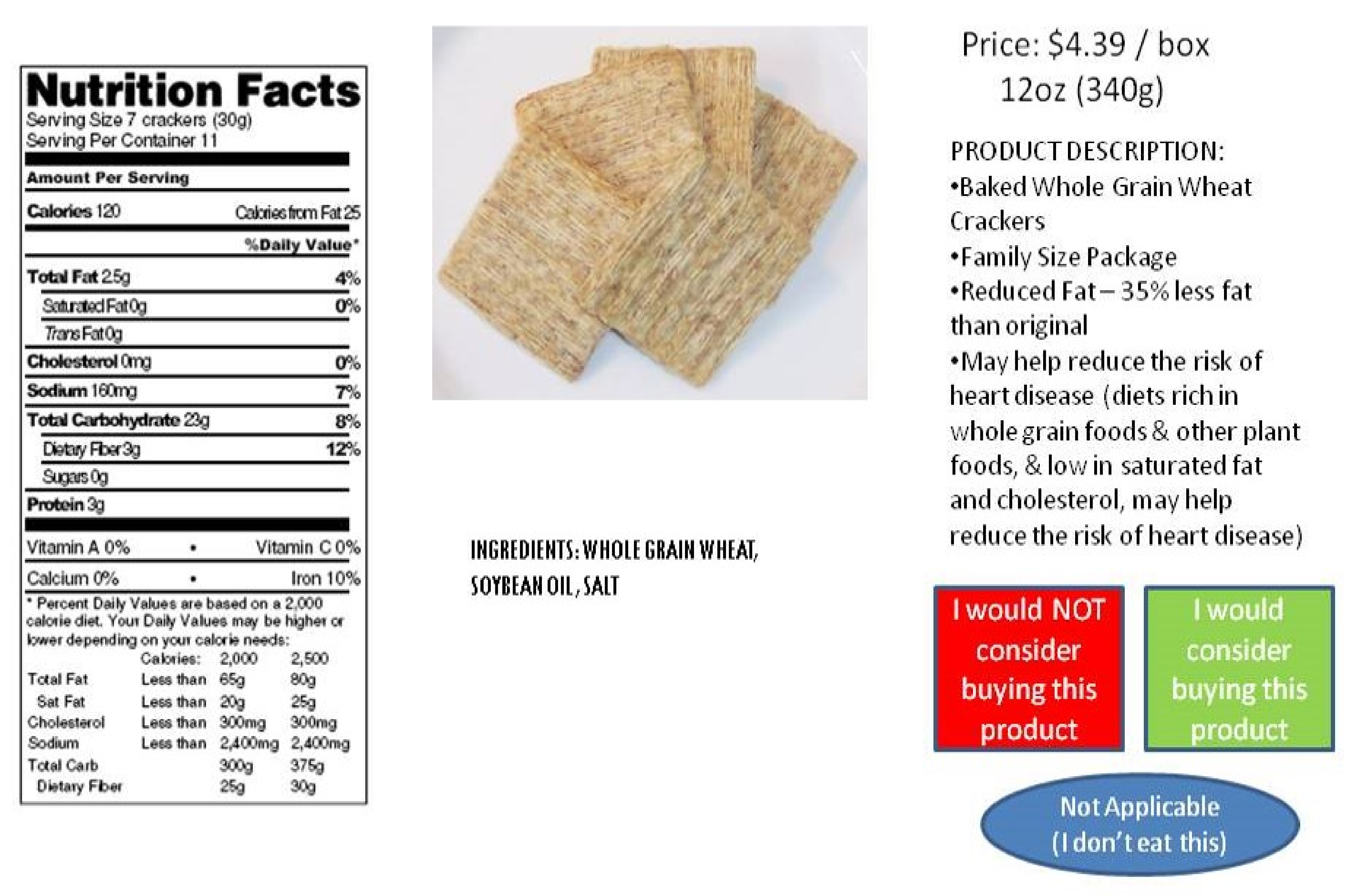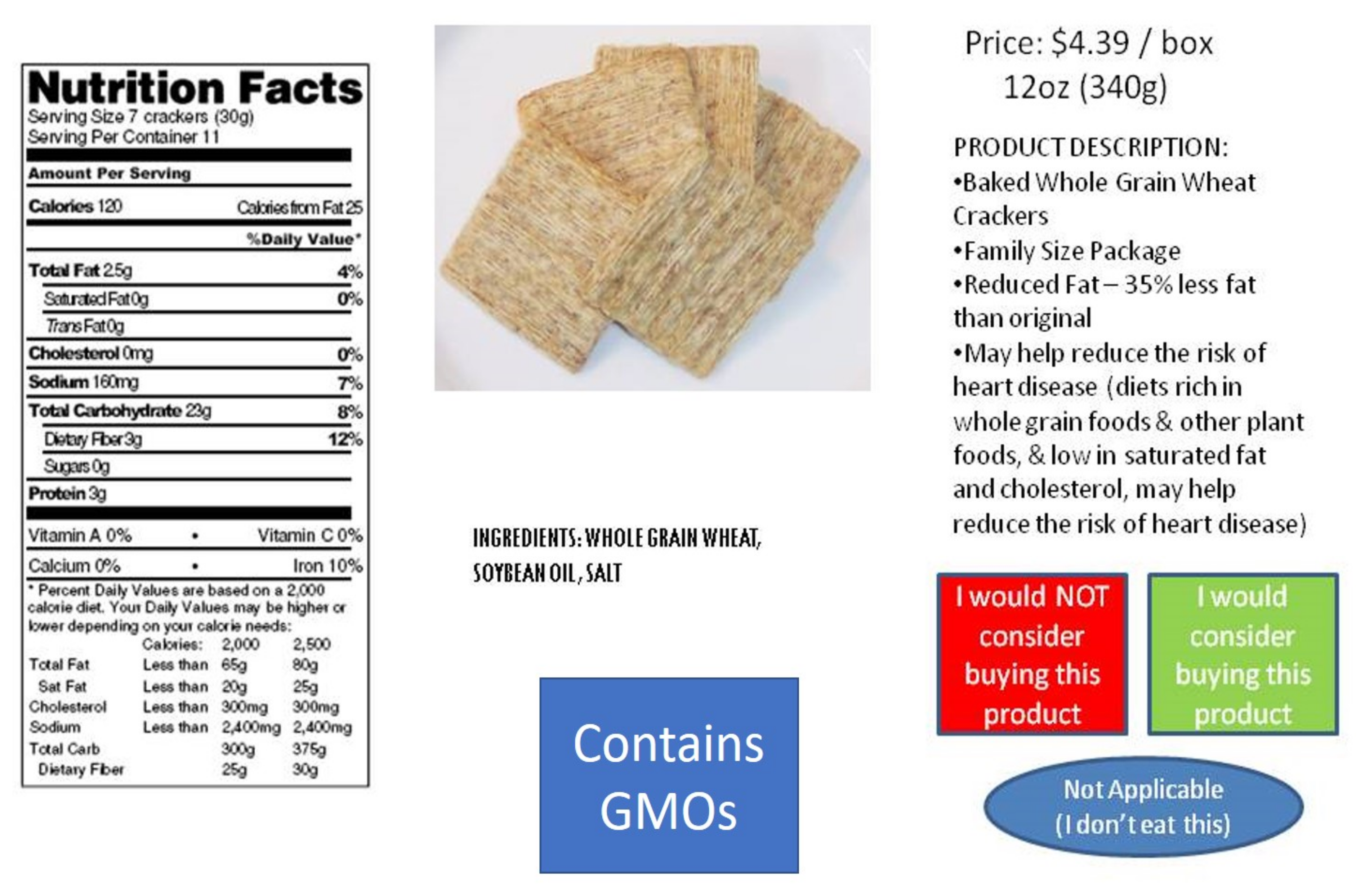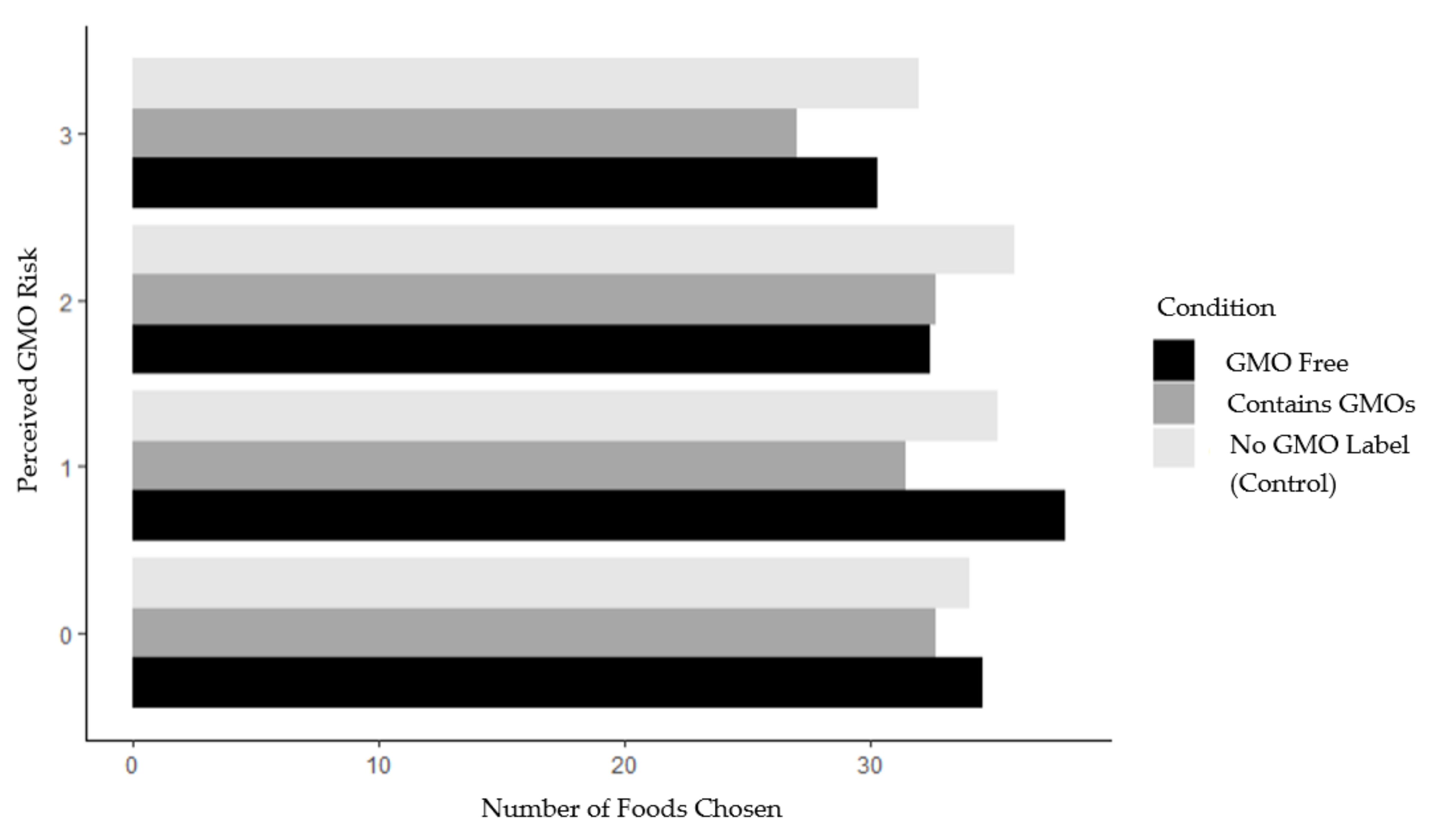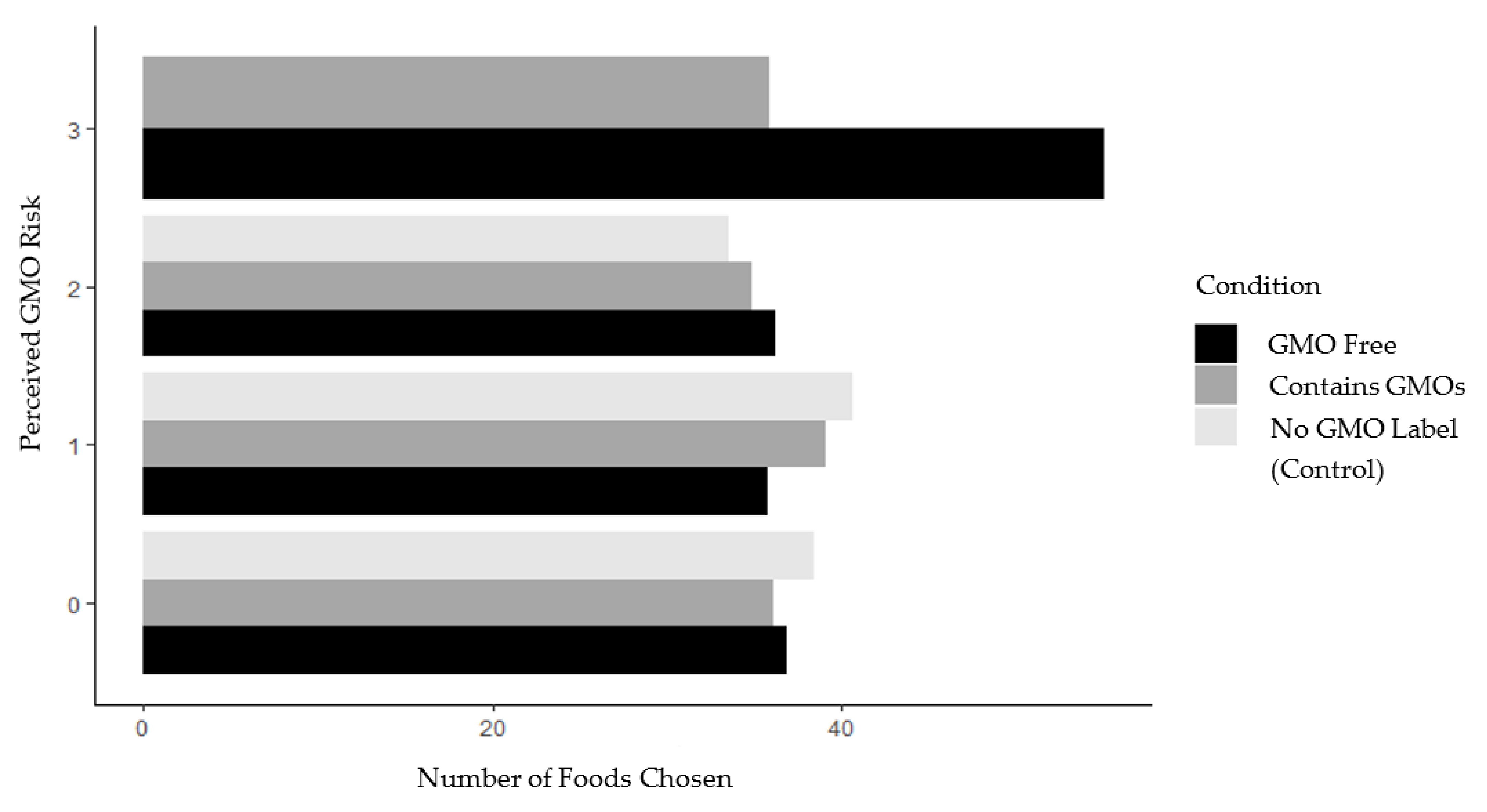GMO Food Labels Do Not Affect College Student Food Selection, Despite Negative Attitudes towards GMOs
Abstract
1. Introduction
Hypotheses
- The number of foods selected will be lower for products with contains GMOs labels compared to unlabeled products
- The number of foods selected will be higher for products with GMO free labels compared to those with no labels.
- a
- Rationale: Conversely, the research team predicted that the presence of GMO free labels would have the opposite effect. Since a large proportion of consumers hold negative attitudes towards GMOs, labels stating the absence of genetic modification would be expected to encourage purchasing among those who are averse to such practices;
- Risk perception will interact with the label type such that, as the perceived GMO risk increases, the number of foods selected for items with contains GMOs labels will decrease and the number of foods selected labeled GMO free will increase.
- a
- Rationale: For those who perceive a higher risk associated with GMO consumption, labels indicating the presence of genetic modification will prompt participants to avoid those products, while GMO free labels will signal safety and encourage consumer choice.
2. Materials and Methods
2.1. Study Design
2.2. Participants
2.3. Procedures
2.4. Measures
2.4.1. Outcome Variable: Food Choice
2.4.2. Covariates: Post-Food-Selection Questionnaire
2.4.3. Eye-Tracking Data
2.5. Analyses
3. Results
4. Discussion
4.1. Strengths and Limitations
4.2. Policy Implications
4.3. Implications and Future Directions
5. Conclusions
Author Contributions
Funding
Institutional Review Board Statement
Informed Consent Statement
Data Availability Statement
Conflicts of Interest
Appendix A
| Condition | Foods Selected (of 64 Foods) Phase 1 | Foods Selected (of 32 Foods with Labels in GMO Conditions) Phase 1 | Foods Selected (of 64 Foods) Phase 2 | Foods Selected (of 32 Foods with Labels in GMO Conditions) Phase 2 |
|---|---|---|---|---|
| GMO free | 35.26 | 17.43 | 36.33 | 18.33 |
| Contains GMOs | 31.89 | 15.81 | 36.72 | 18.21 |
| No label (control) | 34.94 | 17.51 (Free)/17.43 (Contains) | 37.69 | 18.50 |
Appendix B



Appendix C
| Phase 1 | Phase 2 | ||||||
|---|---|---|---|---|---|---|---|
| Item | GMO Free | Contains GMOs | Control | GMO Free | Contains GMOs | Control | |
| 1 | Crackers (Whole Wheat) | Free a | -- b | -- | Free | Contains c | -- |
| 2 | Crackers (Soda) | -- | Contains | -- | -- | -- | -- |
| 3 | Crackers (Multigrain) | Free | -- | -- | Free | Contains | -- |
| 4 | Crackers (Nut Flour) | -- | Contains | -- | -- | -- | -- |
| 5 | Peanuts (Salted, No Shell) | Free | -- | -- | Free | Contains | -- |
| 6 | Peanuts (Honey Roasted, No Shell) | -- | Contains | -- | -- | -- | -- |
| 7 | Almonds (Cinnamon) | Free | -- | -- | Free | Contains | -- |
| 8 | Almonds (Plain, Salted) | -- | Contains | -- | -- | -- | -- |
| 9 | Cereal (Wheat Biscuits, No Frosting) | Free | -- | -- | Free | Contains | -- |
| 10 | Cereal (Wheat Flakes) | -- | Contains | -- | -- | -- | -- |
| 11 | Cereal (Corn Flakes, Frosted) | Free | -- | -- | Free | Contains | -- |
| 12 | Cereal (Oat Cereal, Honey Nut Flavored) | -- | Contains | -- | -- | -- | -- |
| 13 | Cereal (Wheat Biscuits, Frosted) | Free | -- | -- | Free | Contains | -- |
| 14 | Cookies (Fig Bars) | -- | Contains | -- | -- | -- | -- |
| 15 | Cookies (Chocolate Chip, Crunchy) | Free | -- | -- | Free | Contains | -- |
| 16 | Cookies (Chocolate Chip, Chewy) | -- | Contains | -- | -- | -- | -- |
| 17 | Cookies (Chocolate Chip, Crunchy, Miniature) | Free | -- | -- | Free | Contains | -- |
| 18 | Cookies (Chocolate Wafer Sandwiches with Vanilla Crème) | -- | Contains | -- | -- | -- | -- |
| 19 | Chips (Multigrain) | Free | -- | -- | Free | Contains | -- |
| 20 | Chips (Potato) | -- | Contains | -- | -- | -- | -- |
| 21 | Chips (Potato, Stackable) | Free | -- | -- | Free | Contains | -- |
| 22 | Chips (Corn) | -- | Contains | -- | -- | -- | -- |
| 23 | Pretzels | Free | -- | -- | Free | Contains | -- |
| 24 | Rice Cakes | -- | Contains | -- | -- | -- | -- |
| 25 | Cheese Puffs | Free | -- | -- | Free | Contains | -- |
| 26 | Popcorn | -- | Contains | -- | -- | -- | -- |
| 27 | Fruit Cocktail (in 100% Juice) | Free | -- | -- | Free | Contains | -- |
| 28 | Fruit Cocktail (in Syrup) | -- | Contains | -- | -- | -- | -- |
| 29 | Apple Sauce | Free | -- | -- | Free | Contains | -- |
| 30 | Pears (Canned, No Sugar Added) | -- | Contains | -- | -- | -- | -- |
| 31 | Strawberries (Frozen) | Free | -- | -- | Free | Contains | -- |
| 32 | Blueberries (Frozen) | -- | Contains | -- | -- | -- | -- |
| 33 | Raspberries (Frozen) | Free | -- | -- | Free | Contains | -- |
| 34 | Mixed Fruit (Frozen) | -- | Contains | -- | -- | -- | -- |
| 35 | Pizza (Large, Frozen, Cheese) | Free | -- | -- | Free | Contains | -- |
| 36 | Pizza (Small, Frozen, Cheese) | -- | Contains | -- | -- | -- | -- |
| 37 | Pizza (Bite-sized, Frozen, Cheese) | Free | -- | -- | Free | Contains | -- |
| 38 | Pizza (Pockets, Frozen, Cheese) | -- | Contains | -- | -- | -- | -- |
| 39 | Pizza (Focaccia, Frozen, Cheese) | Free | -- | -- | Free | Contains | -- |
| 40 | Yogurt (Plain) | -- | Contains | -- | -- | -- | -- |
| 41 | Yogurt (Peach) | Free | -- | -- | Free | Contains | -- |
| 42 | Yogurt (Blueberry) | -- | Contains | -- | -- | -- | -- |
| 43 | Yogurt (Strawberry) | Free | -- | -- | Free | Contains | -- |
| 44 | Ice Cream (Vanilla, Low Fat) | -- | Contains | -- | -- | -- | -- |
| 45 | Ice Cream (Vanilla, Full Fat) | Free | -- | -- | Free | Contains | -- |
| 46 | Ice Cream (Chocolate Chip Cookie Dough) | -- | Contains | -- | -- | -- | -- |
| 47 | Ice Cream (Mint Chocolate Cookie) | Free | -- | -- | Free | Contains | -- |
| 48 | Turkey (Smoked) | -- | Contains | -- | -- | -- | -- |
| 49 | Turkey (Oven Roasted) | Free | -- | -- | Free | Contains | -- |
| 50 | Ham (Baked) | -- | Contains | -- | -- | -- | -- |
| 51 | Ham (Honey) | Free | -- | -- | Free | Contains | -- |
| 52 | Soup (Chicken Noodle, Classic, Canned) | -- | Contains | -- | -- | -- | -- |
| 53 | Soup (Chicken Noodle, Lower Sodium, Canned) | Free | -- | -- | Free | Contains | -- |
| 54 | Soup (Vegetable, Boxed) | -- | Contains | -- | -- | -- | -- |
| 55 | Soup (Vegetable, Canned) | Free | -- | -- | Free | Contains | -- |
| 56 | Corn (Low Sodium, Canned) | -- | Contains | -- | -- | -- | -- |
| 57 | Corn (Regular, Canned) | Free | -- | -- | Free | Contains | -- |
| 58 | Peas (Regular, Canned) | -- | Contains | -- | -- | -- | -- |
| 59 | Mixed Vegetables (Regular, Canned) | Free | -- | -- | Free | Contains | -- |
| 60 | Peas (Regular, Frozen) | -- | Contains | -- | -- | -- | -- |
| 61 | Mixed Vegetables (Regular, Frozen) | Free | -- | -- | Free | Contains | -- |
| 62 | Corn (Regular, Frozen) | -- | Contains | -- | -- | -- | -- |
| 63 | Corn (Organic, Frozen) | Free | -- | -- | Free | Contains | -- |
| 64 | Peas (Organic, Frozen) | -- | Contains | -- | -- | -- | -- |
References
- BE Disclosure Agricultural Marketing Service. Available online: https://www.ams.usda.gov/rules-regulations/be (accessed on 17 December 2020).
- Yeh, D.A.; Gómez, M.I.; Kaiser, H.M. Signaling Impacts of GMO Labeling on Fruit and Vegetable Demand. PLoS ONE 2019, 14, e0223910. [Google Scholar] [CrossRef]
- Stop the Food Label Fear-Mongering. Available online: https://www.usnews.com/opinion/articles/2018-01-30/stop-the-food-label-fear-mongering (accessed on 17 December 2020).
- Hemphill, T.A.; Banerjee, S. Genetically Modified Organisms and the U.S. Retail Food Labeling Controversy: Consumer Perceptions, Regulation, and Public Policy. Bus. Soc. Rev. 2015, 120, 435–464. [Google Scholar] [CrossRef]
- Bardin, B.; Perrissol, S.; Facca, L.; Smeding, A. From Risk Perception to Information Selection…And Not the Other Way Round: Selective Exposure Mechanisms in the Field of Genetically Modified Organisms. Food Qual. Prefer. 2017, 58, 10–17. [Google Scholar] [CrossRef]
- Runge, K.K.; Brossard, D.; Scheufele, D.A.; Rose, K.M.; Larson, B.J. Attitudes about Food and Food-Related Biotechnology. Public Opin. Q. 2017, 81, 577–596. [Google Scholar] [CrossRef]
- Editor, K.T.H. Managing What Do Consumers Think of GMOs? Available online: https://www.foodprocessing.com/articles/2018/what-do-consumers-think-of-gmos/ (accessed on 17 December 2020).
- Lusk, J.; Jamal, M.; Kurlander, L.; Roucan, M.; Taulman, L. A Meta-Analysis of Genetically Modified Food Valuation Studies. J. Agric. Resour. Econ. 2005, 30. [Google Scholar] [CrossRef]
- Ardebili, A.T.; Rickertsen, K. Personality Traits, Knowledge, and Consumer Acceptance of Genetically Modified Plant and Animal Products. Food Qual. Prefer. 2020, 80, 103825. [Google Scholar] [CrossRef]
- Kim, J.; Fang, S. Decisions to Choose Genetically Modified Foods: How Do People’s Perceptions of Science and Scientists Affect Their Choices? J. Sci. Commun. 2020, 19, A01. [Google Scholar] [CrossRef]
- About Half of U.S. Adults Are Wary of Health Effects of Genetically Modified Foods, but Many Also See Advantages. Pew. Res. Cent. Available online: https://www.pewresearch.org/fact-tank/2020/03/18/about-half-of-u-s-adults-are-wary-of-health-effects-of-genetically-modified-foods-but-many-also-see-advantages/ (accessed on 2 February 2021).
- Survey: Nearly Half of U.S. Consumers Avoid GMO Foods; Large Majority Primarily Concerned About Human Health Impact. Food Insight 2018. Available online: https://foodinsight.org/survey-nearly-half-of-u-s-consumers-avoid-gmo-foods-large-majority-primarily-concerned-about-human-health-impact/#:~:text=The%20survey%20also%20asked%20about%20broader%20perceptions%20of%20GMOs.&text=The%20vast%20majority%20(85%20percent,percent)%20concerns%20trailing%20far%20behind (accessed on 10 February 2021).
- Li, A.S.W.; Figg, G.; Schüz, B. Socioeconomic Status and the Prediction of Health Promoting Dietary Behaviours: A Systematic Review and Meta-Analysis Based on the Theory of Planned Behaviour. Appl. Psychol. Health Well-Being 2019, 11, 382–406. [Google Scholar] [CrossRef]
- McDermott, M.S.; Oliver, M.; Svenson, A.; Simnadis, T.; Beck, E.J.; Coltman, T.; Iverson, D.; Caputi, P.; Sharma, R. The Theory of Planned Behaviour and Discrete Food Choices: A Systematic Review and Meta-Analysis. Int. J. Behav. Nutr. Phys. Act. 2015, 12, 162. [Google Scholar] [CrossRef]
- Ajzen, I. The Theory of Planned Behavior. Organ. Behav. Hum. Decis. Process. 1991, 50, 179–211. [Google Scholar] [CrossRef]
- Riebl, S.K.; Estabrooks, P.A.; Dunsmore, J.C.; Savla, J.; Frisard, M.I.; Dietrich, A.M.; Peng, Y.; Zhang, X.; Davy, B.M. A Systematic Literature Review and Meta-Analysis: The Theory of Planned Behavior’s Application to Understand and Predict Nutrition-Related Behaviors in Youth. Eat. Behav. 2015, 18, 160–178. [Google Scholar] [CrossRef] [PubMed]
- Nardi, V.A.M.; Jardim, W.C.; Ladeira, W.; Santini, F. Predicting Food Choice: A Meta-Analysis Based on the Theory of Planned Behavior. Br. Food J. 2019, 121, 2250–2264. [Google Scholar] [CrossRef]
- Boulstridge, E.; Carrigan, M. Do Consumers Really Care About Corporate Responsibility? Highlighting the Attitude-Behavior Gap. J. Commun. Manag. 2000, 4, 355–368. [Google Scholar] [CrossRef]
- Sultan, P.; Tarafder, T.; Pearson, D.; Henryks, J. Intention-Behaviour Gap and Perceived Behavioural Control-Behaviour Gap in Theory of Planned Behaviour: Moderating Roles of Communication, Satisfaction and Trust in Organic Food Consumption. Food Qual. Prefer. 2020, 81, 103838. [Google Scholar] [CrossRef]
- Frank, P.; Brock, C. Bridging the Intention–Behavior Gap among Organic Grocery Customers: The Crucial Role of Point-of-sale Information. Psychol. Mark. 2018, 35, 586–602. [Google Scholar] [CrossRef]
- Aschemann-Witzel, J.; Aagaard, E.M.N. Elaborating on the Attitude–Behaviour Gap Regarding Organic Products: Young Danish Consumers and in-Store Food Choice. Int. J. Consum. Stud. 2014, 38, 550–558. [Google Scholar] [CrossRef]
- Tobi, R.; Harris, F.; Brown, K.; Quaife, M.; Green, R. Sustainable Diet Dimensions. Comparing Consumer Preference for Nutrition, Environmental and Social Responsibility Food Labelling: A Systematic Review. Sustainability 2019, 11, 6575. [Google Scholar] [CrossRef]
- Ghvanidze, S.; Velikova, N.; Dodd, T.; Oldewage-Theron, W. A Discrete Choice Experiment of the Impact of Consumers’ Environmental Values, Ethical Concerns, and Health Consciousness on Food Choices: A Cross-Cultural Analysis. Br. Food J. 2017, 119, 863–881. [Google Scholar] [CrossRef]
- Hidalgo-Baz, M.; Martos-Partal, M.; González-Benito, Ó. Attitudes vs. Purchase Behaviors as Experienced Dissonance: The Roles of Knowledge and Consumer Orientations in Organic Market. Front. Psychol. 2017, 8. [Google Scholar] [CrossRef]
- Roe, B.; Teisl, M.F. Genetically Modified Food Labeling: The Impacts of Message and Messenger on Consumer Perceptions of Labels and Products. Food Policy 2007, 32, 49–66. [Google Scholar] [CrossRef]
- Hartman, L.R. Product Development What the New Food Demographics Mean for Food and Beverage. Available online: https://www.foodprocessing.com/articles/2016/new-food-demographics/ (accessed on 17 December 2020).
- Bumbac, R.; Bobe, M.; Procopie, R.; Pamfilie, R.; Giușcă, S.; Enache, C. How Zoomers’ Eating Habits Should Be Considered in Shaping the Food System for 2030—A Case Study on the Young Generation from Romania. Sustainability 2020, 12, 7390. [Google Scholar] [CrossRef]
- Graham, D.; Laska, M. Nutrition Label Use Partially Mediates the Relationship between Attitude toward Healthy Eating and Overall Dietary Quality among College Students. J. Acad. Nutr. Diet. 2012, 112, 414–418. [Google Scholar] [CrossRef]
- Kamenidou, I.C.; Mamalis, S.A.; Pavlidis, S.; Bara, E.-Z.G. Segmenting the Generation Z Cohort University Students Based on Sustainable Food Consumption Behavior: A Preliminary Study. Sustainability 2019, 11, 837. [Google Scholar] [CrossRef]
- Laska, M.; Pasch, K.; Lust, K.; Story, M.; Ehlinger, E. Latent Class Analysis of Lifestyle Characteristics and Health Risk Behaviors among College Youth. Prev. Sci. Off. J. Soc. Prev. Res. 2009, 10, 376–386. [Google Scholar] [CrossRef] [PubMed]
- Asioli, D.; Aschemann-Witzel, J.; Caputo, V.; Vecchio, R.; Annunziata, A.; Næs, T.; Varela, P. Making Sense of the “Clean Label” Trends: A Review of Consumer Food Choice Behavior and Discussion of Industry Implications. Food Res. Int. 2017, 99, 58–71. [Google Scholar] [CrossRef]
- Office, C.S.D. Race Estimates. Available online: https://demography.dola.colorado.gov/population/data/race-estimate/ (accessed on 4 February 2021).
- R: The R Project for Statistical Computing. Available online: https://www.r-project.org/ (accessed on 18 December 2020).
- Liaukonyte, J.; Streletskaya, N.A.; Kaiser, H.M.; Rickard, B.J. Consumer Response to “Contains” and “Free of” Labeling: Evidence from Lab Experiments. Appl. Econ. Perspect. Policy 2013, 35, 476–507. [Google Scholar] [CrossRef]
- Kemper, N.P.; Popp, J.S.; Nayga, R.M.; Kerr, J.B. Cultural Worldview and Genetically Modified Food Policy Preferences. Food Policy 2018, 80, 68–83. [Google Scholar] [CrossRef]
- Lefebvre, S.; Cook, L.A.; Griffiths, M.A. Consumer Perceptions of Genetically Modified Foods: A Mixed-Method Approach. J. Consum. Mark. 2019, 36, 113–123. [Google Scholar] [CrossRef]
- Schouteten, J.J.; Gellynck, X.; De Steur, H. Consumers’ Perceptions of GM-free Labelled Foods: A Sensory Experiment. Int. J. Consum. Stud. 2018, 42, 347–357. [Google Scholar] [CrossRef]
- Bovay, J.; Alston, J.M. GMO Food Labels in the United States: Economic Implications of the New Law. Food Policy 2018, 78, 14–25. [Google Scholar] [CrossRef]
- Kolodinsky, J.; Morris, S.; Pazuniak, O. How Consumers Use Mandatory Genetic Engineering (GE) Labels: Evidence from Vermont. Agric. Hum. Values 2019, 36, 117–125. [Google Scholar] [CrossRef]
- Hartmann, C.; Hieke, S.; Taper, C.; Siegrist, M. European Consumer Healthiness Evaluation of ‘Free-from’ Labelled Food Products. Food Qual. Prefer. 2018, 68, 377–388. [Google Scholar] [CrossRef]
- Sax, J.K.; Doran, N. Food Labeling and Consumer Associations with Health, Safety, and Environment. J. Law Med. Ethics 2016, 44, 630–638. [Google Scholar] [CrossRef] [PubMed]
- New Plant Variety Regulatory Information. Available online: https://www.fda.gov/food/food-new-plant-varieties/new-plant-variety-regulatory-information (accessed on 2 February 2021).
- Centanni, J.; Jancsura, A.; Sidaras, B.; Arburn, G.W. Public Knowledge of Genetically Modified Organisms in Food and the Impact on Businesses: Evidence from The U.S. Glob. J. Bus. Res. 2017, 11, 27–37. [Google Scholar]
- The GMO Labeling Battle Is Heating Up—Here’s Why—Nat Geo Food. Available online: https://www.nationalgeographic.com/news/2014/1/140111-genetically-modified-organisms-gmo-food-label-cheerios-nutrition-science/ (accessed on 18 December 2020).
- What You Need to Know about GMOs. Available online: https://www.usatoday.com/story/news/nation-now/2014/01/03/gmo-genetically-modified-organism-facts-cheerios/4302121/ (accessed on 18 December 2020).
- Wunderlich, S.; Gatto, K.A. Consumer Perception of Genetically Modified Organisms and Sources of Information123. Adv. Nutr. 2015, 6, 842–851. [Google Scholar] [CrossRef] [PubMed]
- Americans Are Narrowly Divided over Health Effects of Genetically Modified Foods. Pew Res. Cent. Available online: https://www.pewresearch.org/fact-tank/2018/11/19/americans-are-narrowly-divided-over-health-effects-of-genetically-modified-foods/ (accessed on 2 February 2021).
- Feldmann, C.; Hamm, U. Consumers’ Perceptions and Preferences for Local Food: A Review. Food Qual. Prefer. 2015, 40, 152–164. [Google Scholar] [CrossRef]
- Redondo, I.; Puelles, M. The Connection between Environmental Attitude-Behavior Gap and Other Individual Inconsistencies: A Call for Strengthening Self-Control. Int. Res. Geogr. Environ. Educ. 2017, 26, 107–120. [Google Scholar] [CrossRef]


| Survey Participant Demographics (n = 434) | ||
|---|---|---|
| Phase 1 | Phase 2 | |
| Gender (% Female) | 62% | 61% |
| Mean Age (in years) | 18.83 (D = 1.19) | 19.04 (SD = 2.05) |
| Race/Ethnicity (% White) | 84.9% | 82.1% |
| Race/Ethnicity (% Hispanic) | 14.6% | 17.1% |
| Race/Ethnicity (% Black) | 3.6% | 1.8% |
| Race/Ethnicity (% Other) | 11.3% | 15.7% |
| Predictor | b | B 95% CI [LL, UL] | Beta | Beta 95% CI [LL, UL] | sr2 | sr2 95% CI [LL, UL] | r | Fit |
|---|---|---|---|---|---|---|---|---|
| (Intercept) | 34.94 | [32.86, 37.02] | ||||||
| GMO free | 0.31 | [−2.63, 3.26] | 0.02 | [−0.14, 0.17] | 0.00 | [−0.00, 0.00] | 0.09 | |
| Contains GMO | −3.05 | [−6.08, −0.03] | −0.16 | [−0.32, −0.00] | 0.02 | [−0.02, 0.06] | −0.17 | |
| R2 = 0.028 | ||||||||
| 95% CI [0.00, 0.08] |
| Predictor | b (se) | Beta | Beta 95% CI [LL, UL] | sr2 | sr2 95% CI [LL, UL] | r | Fit |
|---|---|---|---|---|---|---|---|
| (Intercept) | 43.31 (11.2) | ||||||
| GMO free | 0.20 (1.56) | 0.01 | [−0.15, 0.17] | 0.00 | [−0.00, 0.00] | 0.08 | |
| Contains GMOs | −2.83 (1.61) | −0.15 | [−0.31, 0.02] | 0.02 | [−0.02, 0.05] | −0.17 | |
| Age | −0.22 (0.55) | −0.03 | [−0.18, 0.12] | 0.00 | [−0.01, 0.01] | −0.03 | |
| Sex | −0.96 (1.40) | −0.05 | [−0.20, 0.10] | 0.00 | [−0.01, 0.02] | −0.09 | |
| Ethnicity | −2.02 (1.18) | −0.13 | [−0.27, 0.02] | 0.02 | [−0.02, 0.05] | −0.13 | |
| Race | −0.07 (0.17) | −0.03 | [−0.18, 0.11] | 0.00 | [−0.01, 0.01] | −0.01 | |
| R2 = 0.048 | |||||||
| 95% CI [0.00, 0.09] | |||||||
| Condition | Foods Selected (of 64): Phase 1 | Foods Selected (of 64): Phase 2 |
|---|---|---|
| GMO free | 35.26 | 36.33 |
| Contains GMOs | 31.89 | 36.72 |
| No label (control) | 34.94 | 37.69 |
| Predictor | b | b 95% CI [LL, UL] | Beta | Beta 95% CI [LL, UL] | sr2 | sr2 95% CI [LL, UL] | r | Fit |
|---|---|---|---|---|---|---|---|---|
| (Intercept) | 37.69 | [35.11, 40.27] | ||||||
| GMO free | −1.36 | [−4.71, 1.99] | −0.07 | [−0.25, 0.10] | 0.00 | [−0.01, 0.02] | −0.03 | |
| Contains GMOs | −0.97 | [−3.94, 2.00] | −0.06 | [−0.23, 0.12] | 0.00 | [−0.01, 0.01] | −0.01 | |
| R2 = 0.003 | ||||||||
| 95% CI [0.00, 0.02] |
| Predictor | b (se) | beta | Beta 95% CI [LL, UL] | sr2 | sr2 95% CI [LL, UL] | r | Fit |
|---|---|---|---|---|---|---|---|
| (Intercept) | 51.85 (5.98) | ||||||
| GMO free | −0.95 (1.73) | −0.05 | [−0.23, 0.13] | 0.00 | [−0.01, 0.01] | −0.04 | |
| Contains GMOs | −0.44 (1.53) | −0.03 | [−0.20, 0.15] | 0.00 | [−0.00, 0.01] | 0.01 | |
| Age | −0.53 (0.28) | −0.13 | [−0.26, 0.01] | 0.02 | [−0.02, 0.05] | −0.11 | |
| Sex | −2.41 (1.18) | −0.14 | [−0.27, 0.00] | 0.02 | [−0.02, 0.05] | −0.12 | |
| Ethnicity | −0.31 (0.54) | −0.04 | [−0.17, 0.09] | 0.00 | [−0.01, 0.01] | −0.06 | |
| Race | −0.04 (0.15) | −0.02 | [−0.15, 0.11] | 0.00 | [−0.00, 0.00] | −0.02 | |
| R2 = 0.036 | |||||||
| 95% CI [0.00, 0.07] | |||||||
Publisher’s Note: MDPI stays neutral with regard to jurisdictional claims in published maps and institutional affiliations. |
© 2021 by the authors. Licensee MDPI, Basel, Switzerland. This article is an open access article distributed under the terms and conditions of the Creative Commons Attribution (CC BY) license (http://creativecommons.org/licenses/by/4.0/).
Share and Cite
Oselinsky, K.; Johnson, A.; Lundeberg, P.; Johnson Holm, A.; Mueller, M.; Graham, D.J. GMO Food Labels Do Not Affect College Student Food Selection, Despite Negative Attitudes towards GMOs. Int. J. Environ. Res. Public Health 2021, 18, 1761. https://doi.org/10.3390/ijerph18041761
Oselinsky K, Johnson A, Lundeberg P, Johnson Holm A, Mueller M, Graham DJ. GMO Food Labels Do Not Affect College Student Food Selection, Despite Negative Attitudes towards GMOs. International Journal of Environmental Research and Public Health. 2021; 18(4):1761. https://doi.org/10.3390/ijerph18041761
Chicago/Turabian StyleOselinsky, Katrina, Ashlie Johnson, Pamela Lundeberg, Abby Johnson Holm, Megan Mueller, and Dan J. Graham. 2021. "GMO Food Labels Do Not Affect College Student Food Selection, Despite Negative Attitudes towards GMOs" International Journal of Environmental Research and Public Health 18, no. 4: 1761. https://doi.org/10.3390/ijerph18041761
APA StyleOselinsky, K., Johnson, A., Lundeberg, P., Johnson Holm, A., Mueller, M., & Graham, D. J. (2021). GMO Food Labels Do Not Affect College Student Food Selection, Despite Negative Attitudes towards GMOs. International Journal of Environmental Research and Public Health, 18(4), 1761. https://doi.org/10.3390/ijerph18041761







